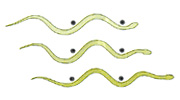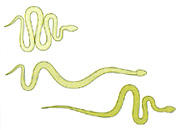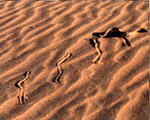The most telling sign of snakes is their shape. The lengthening of the body and the reduction or loss of limbs occurred several times in vertebrate evolution. This change in body shape has profound consequences on the biology of an animal, and obviously on his way of moving.
The backbone of snakes offers several characters related to locomotion legless. First, the number of vertebrae is greatly increased, making the spine more flexible. The man has only 32 vertebrae, while some snakes have more than 400. Then, the snakes have additional apophyses on the vertebrae, which improves the connections between them and increases the stability of the spine.
Rectilinear motion

In rectilinear locomotion, the snake straight ahead and uses the movement of the abdominal skin from the rest of the body. Successive groups of ventral scales are lifted and moved forward and anchored by their outer edge. With these points of support, the rest of the body is then advanced, then the movement is repeated.
Large pythons, boas and vipers often adopt this straight locomotion, where the increase results from a series of contractions and relaxation of muscles, especially when they crawl towards their prey in the open. The movements are slow and difficult to detect when it is moving this way
Lateral undulation

This is the mode of travel the most common. The snake uses a point of ground contact for support. Then he raises the trunk above the ground to establish another point of contact.
Concertina movement :

To save space, the snake contracts its muscles in the back, as it expands its front and front to bring back
Running side

Lateral locomotion is particularly suitable for soft substrates such as sand or mud, where there is little chance of finding irregularities to the undulations usual solid. Small desert vipers and snakes living in muddy areas rely on this mode of locomotion.
Moving Water
Most marine species have a tail flattened paddle-shaped swimming



